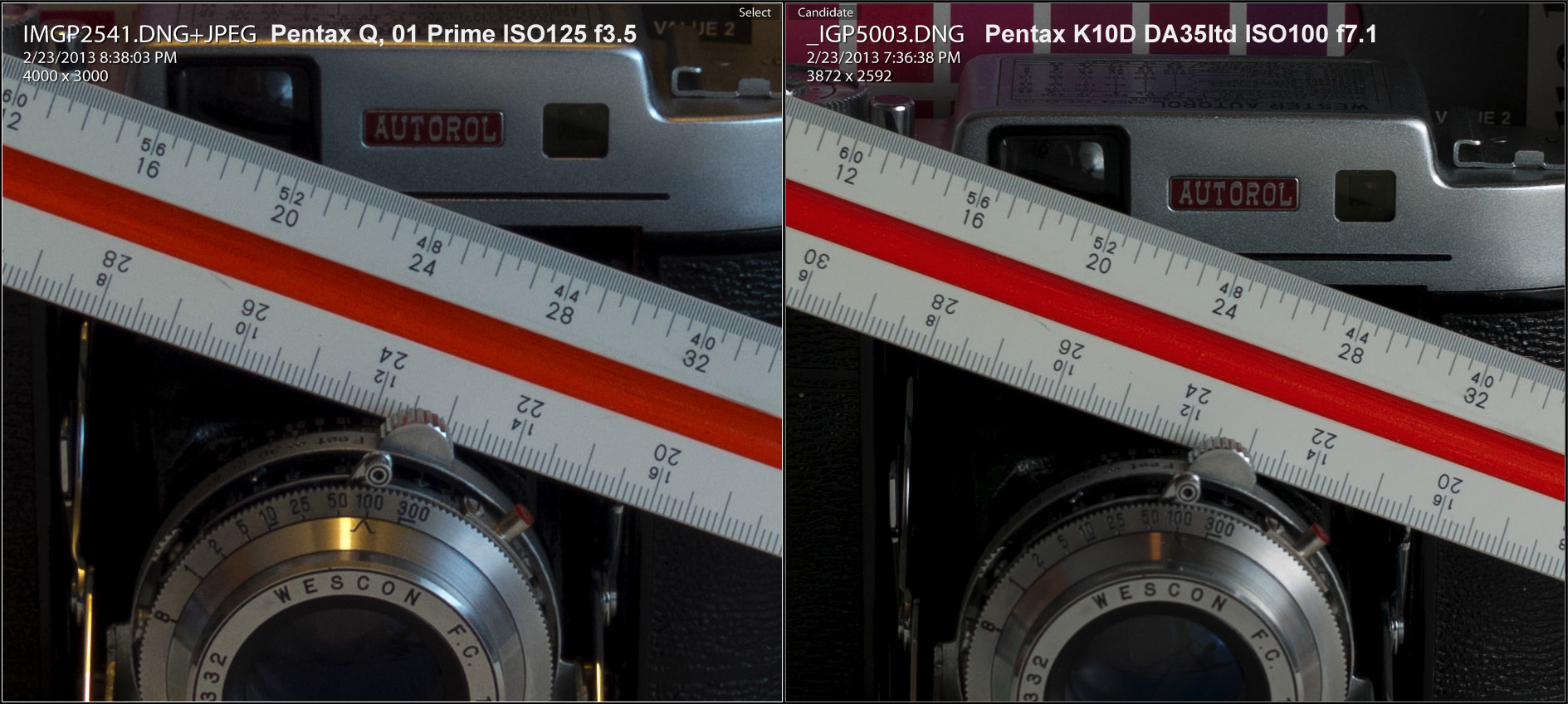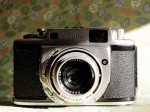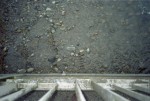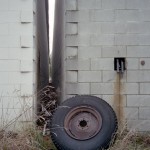Feb
28
2013
When Pentax released the tiny mirrorless Q camera a lot of people’s immediate reaction was to dismiss it solely based on its sensor size of 1/2.3″ (6.17 x 4.55 mm), but in doing that I think they are missing the point. I don’t see the Q as a replacement for any other type of camera necessarily but something entirely unique. I find the image quality adequate for snap shots particularly with the 8.5mm prime lens and with the addition of the fisheye lens there is nothing else like it that can fit in a coat pocket. The only time I choose to take my larger Nikon P7000 is if I think I will need the longer lens but that too can be addressed with the recently announced Pentax 06 zoom with its f2.8 83mm to 249mm equivalent in terms of “full frame”. But as this is a comparison of sorts, despite the difference between the type of cameras what really matters is the image in the end. Yes the K10D is now 6 years old but it’s still a DSLR and you would expect it to decisively out perform the Q if you just look at the size of the sensors.

For this test I used the Pentax 01 Prime lens at an aperture of f3.5 which gave me enough depth of field for my scene yet did not result in a softening of the image due to diffraction. For the K10D I used the excellent Pentax SMC DA35 ltd. at an aperture of f7.1 which also yielded enough depth of field and good lens performance. There is a small difference in the field of view for these lenses so I did my best to match it and also the Q sits much lower on the tripod so I had to adjust for that as well. Both cameras were set to P-TTL flash exposure using two AF540fgz flashes into an umbrella. I found the Q exposure and colour to be slightly more accurate but both were shot as RAW. My purpose was not to test the two cameras necessarily at the same setting but at their individual best much as I would try to use them.

You can see in this first example that the K10D’s rendering of the bristles is much sharper and better defined. This is from an area of the image some way from the center but not really yet a corner. Chalk one up to the K10D and the DA35 ltd

Towards the center of the image I find it to be a bit of a toss-up they both seem to have a similar level of sharpness with the slightly higher resolution of the Q perhaps allowing for more detail, I would call this a tie though when I take into account what appears to be slightly different point of sharpest focus.

At 1600 ISO though the two cameras behave very differently there is more noise in the Pentax Q image but it also retains more detail as seen in the marks on the ruler. As a person that still shoots 1 to 2 rolls of film a week I find the Q produces noise that looks a lot more like film grain so I prefer it. What I take from this testing is that for everyday shooting the Q performs well enough that it can be my primary camera and only when I need to do something outside its capabilities is it necessary to choose something else. Of course many people are saying this of smart phones with their cameras so it stands to reason that the Q is up to that task. A small amount of online research shows just how much effort is going into engineering small sensors mostly because of smart phones so there is likely to be a quicker and more dramatic level of development in this area.
5 comments | tags: K10D, Pentax, Q | posted in Cameras, Photography
Feb
25
2013
Not a very flattering nick name for a camera I will admit but a lump is a lump. Being that the camera is now over 50 years old though it can be forgiven. The lens isn’t that fast, having a maximum aperture of 3.5 but the 4 elements in 3 group 45mm ‘Rokkor’ lens is surprisingly good (when it was in focus). My camera needs a little TLC to tighten the lens to the camera body before the two parts part, and to adjust the rangefinder. Its build is nowhere near as good as the Minolta Super A but then it’s not as heavy either.

Despite the issues I had with the rangefinder not working and the lens not being tightly attached to the body (It’s not interchangeable the lens is supposed to stay on) I was surprised by the results which again were obtained on cheap film and without a meter. Its results like this that convince me to do silly things like make cameras from Lego or random camera parts.
Oh I almost forgot this camera has the worst rewind lever ever and took me several minutes just to rewind a roll of 24. As you turn the tiny little wheel, with no mechanical advantage, it goes back almost as far as you just went forward. It was a struggle.
2 comments | posted in Cameras, Photography
Feb
22
2013

I’ve been gravitating towards my Fuji cameras lately. The older the better so this one is the best (actually the Fujica 35SE is but I tell all my cameras they are the best) Okay I don’t actually tell my cameras they are the best that would be weird, I just write about it which isn’t. The most interesting element of this camera is the Copal Magic shutter which can provide completely automatic exposure, I however over ride this and shoot it manually which is less magical.
Yes that’s two beaver statues on one roll of film, If only I could have found one more it would have been a dam party.
2 comments | posted in Cameras, Photography
Feb
20
2013

A diamond treated rough, what a little gem. I love the design and finish, the fact that mine is missing the plastic around the viewfinder and that I’m using hockey tape to seal the back hardly detracts. I also like the notion of the 28mm wide lens which pairs nicely when carrying another camera with a longer focal length.
I try to highlight for each camera one thing that sets it apart and for this Fuji it has to be the focus system. In addition to autofocus there is also manual focus with its many steps between 0.35m and infinity as well as snap focus. Snap focus sets focus to a fixed distance and uses a small aperture to provide a zone where everything is in relative focus. This is great for moving subjects or when focus would otherwise be difficult to achieve.
My first roll of negatives through the camera were all scratched though and I could see when I opened it up a little pile of film powder. I identified the source of it as a bent spring tensioner and fixed it. That is one of the reasons I test cameras with outdated film, to find and fix problems. Sometimes I even like the look old film gives me, but not scratches they aren’t cool.
19 comments | posted in Cameras, Photography
Feb
17
2013

Not bad considering what I did to this camera. In a nut shell I stripped out the mirror, prism and all it’s electronics leaving primarily a lens and a shutter. A well-regarded lens though with it’s 6 elements and wider than normal 40mm focal length.
It functioned and I’m pleased, the pictures turned out well and the only issue seemed to be that the spacing of the negatives was a little inconsistent but none of them actually overlapped. I can now use film I didn’t find in a thrift store in it. Knowing that it works I will also take the time to adjust the viewfinder so that I can try some more careful compositions. I also want to shoot some more images with shallow depth of field which is a real challenge of ones ability to estimate distance but the bokeh seems worth the try.
1 comment | posted in Cameras, Photography
Feb
14
2013

Not much point saving APS film for a rainy day unless it’s in the Minolta Vectis S1, a rainy day camera. As APS film gets further and further from its best before date it goes from bad to worse. This film was a gift from a fellow photographer (DLTphotographic) so I’m not complaining in fact I’m grateful but back in the heyday of APS ( there was no heyday) it was already questionable. That stigma of inferiority still stains the term APS even now when it is much more likely to be used to refer to the digital sensor size APSc. On the basis of only data a digital full frame sensor of the same generation will be better than an APSc sensor but the gap between their performance is no where near the difference between APS film and 35mm film. What point am I trying to make, well there seems to be a general theme on the Internet forums that for serious photography you need to have a “full frame” sensor based camera but this ignores the final output. Two prints from two excellent cameras with good lenses but different size sensors are hard to distinguish. The photographer continues to be the most important part of photography for now. Now here are some crappy pictures to look at.
3 comments | posted in Cameras, Photography
Feb
11
2013
Seeing as I’ve lost track of where I was with the taking of Polaroid pictures and posts I’ve changed directions and am now counting down my remaining stock of Polaroid Spectra film. So here is P minus 24

no comments | tags: film, polaroid | posted in Photography
Feb
8
2013

Well this is a very different post than I thought I would be writing. You see there were only 2 frames left on the roll of film I was shooting when I lost this camera. I’m more annoyed at the loss of images from the last few weeks than of loosing the camera. For that matter it bothers me more to loose the battery than the camera those CR2 batteries are expensive.
1 comment | posted in Photography
Feb
6
2013

While a fish-eye lens is not something you would want to use too often. Much like a hammer isn’t always the right tool, there are times when it is. What really distinguishes this camera lens combination is the fact that it fits in a coat pocket.
Focusing is completely manual and instead of a distance scale there are tiny division marks. Because of the ability to focus from mere inches to infinity while only turning the focus ring about 30 degrees it can be challenging to achieve sharp focus. Using the zoom in while focusing feature of the camera aides this greatly. For other lenses with shallower depth of field, focus peaking is great but with this lens it is not as useful. I also find it a draw back that the lens can be turned past infinity focus, in fact infinity focus is reached at only 3/4 of the total movement. It seems to be best to leave the focus set near the infinity setting and only make adjustments for extreme close ups.
My biggest problem while using this lens though is that I constantly ruin shots by including my hands in the image. It’s so small that it is easy to find after the fact a finger sausage in an image corner. Moving my hands is something I still need to train myself to do after focusing.
7 comments | posted in Cameras
Feb
4
2013

Previously on the Fuji DL500 Files: Our hero was uncertain of the quality from this optical oddity. In this episode it becomes much clearer that the lens performs best at 45mm despite the flare it causes and that the 28mm setting is a poor performer. As the 45mm focal length is achieved by swinging an additional optical group into the light path it is apparent that the central area of the lens is fine, it is the outer corners at which the wide setting fails. After only two episodes the Fuji DL500 files are cancelled.
I’m not quite sure how but according to the Technical Image Press Association it won the award for best 35mm compact camera in 1991, perhaps they never actually took any pictures with it.
8 comments | tags: film, Fuji | posted in Cameras, Photography


































































































